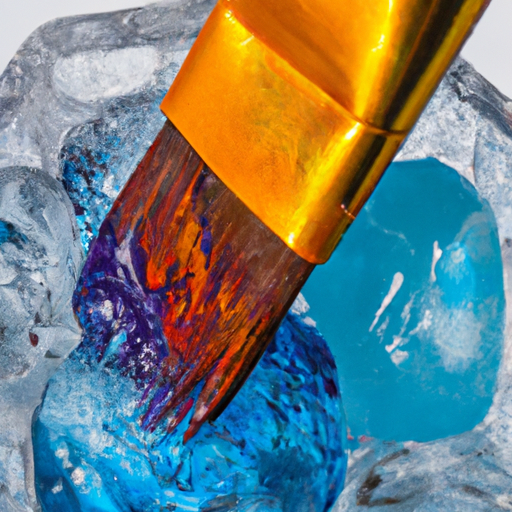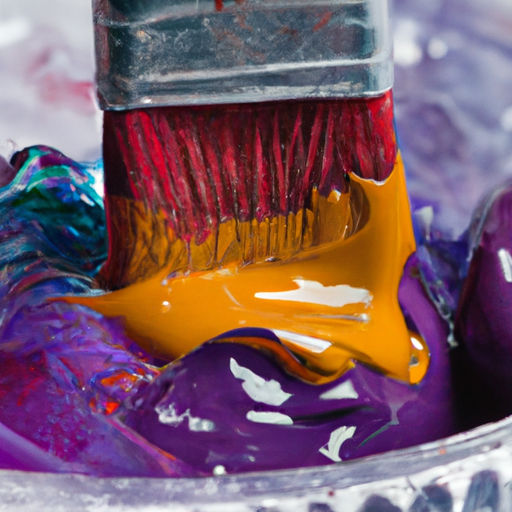Have you ever wondered if acrylic paints can freeze? Well, wonder no more! In this article, we’ll explore whether acrylic paints have the ability to freeze or if they remain unaffected by freezing temperatures. Whether you’re an amateur artist or a seasoned professional, knowing how different mediums react to temperature variations is crucial to maintaining the quality of your artwork. So, let’s dive in and discover the truth about acrylic paints and freezing temperatures.
Understanding Acrylic Paints
Acrylic paints are a versatile and popular medium for artists due to their vibrant colors and ability to be used on a variety of surfaces. However, it is important to have a thorough understanding of their composition, drying process, and durability in order to properly care for and use acrylic paints.
The Composition of Acrylic Paints
Acrylic paints are made up of pigment particles suspended in a polymer emulsion. The pigment particles give the paint its color, while the polymer emulsion acts as a binder that holds the pigment together and allows it to adhere to surfaces. Additionally, acrylic paints may contain additives such as fillers, extenders, or flow enhancers to modify their properties.
The Drying Process of Acrylic Paints
One of the defining characteristics of acrylic paints is their ability to dry quickly. When exposed to air, the water in the paint evaporates and the polymer emulsion forms a film. The thickness of this film determines the drying time, with thin layers drying faster than thick layers.
The Durability of Acrylic Paints
Acrylic paints are known for their durability and long-lasting nature. Once dry, the paint forms a tough and flexible film that is resistant to cracking, fading, and yellowing. This makes acrylic paints ideal for both indoor and outdoor applications, as they can withstand various weather conditions and the test of time.
Factors Affecting Freezing of Acrylic Paints
While acrylic paints are designed to dry quickly, freezing temperatures can have a detrimental effect on their quality. It is important to consider certain factors that can affect the freezing process and take precautions to prevent damage to your acrylic paints.
Temperature Requirements for Freezing
Acrylic paints freeze at temperatures below 32 degrees Fahrenheit or 0 degrees Celsius. Freezing can cause the water in the paint to expand, leading to changes in consistency and separation of components. It is crucial to store acrylic paints in environments where the temperature remains above freezing to avoid these issues.
Chemical Properties of Acrylic Paints
The chemical composition of acrylic paints can also influence their freezing point. Acrylic paints contain water as a solvent, and the freezing point of the solvent affects the overall freezing point of the paint. Different brands and formulations of acrylic paints may have slightly different freezing points, so it is essential to follow the specific freezing guidelines provided by the manufacturer.
Types of Containers for Storing Acrylic Paints
The type of container used to store acrylic paints can play a role in preventing freezing. It is recommended to use airtight containers, such as plastic or glass jars with tight-fitting lids, to minimize air exposure and temperature fluctuations. This helps maintain a consistent temperature and prevents moisture from seeping into the paint.

Effects of Freezing on Acrylic Paints
Freezing can have several negative effects on acrylic paints, which can impact their consistency, components, and pigments. Understanding these effects is crucial in order to take proper precautions and protect the quality of your acrylic paints.
Changes in Consistency
When acrylic paints freeze, the water in the paint expands and affects the overall consistency. The paint may become thicker or clumpy, making it challenging to work with. This can affect the smooth application and blending of the paint, leading to unsatisfactory results.
Separation of Components
Acrylic paints consist of pigment particles suspended in a polymer emulsion. Freezing can cause these components to separate, resulting in an uneven distribution of pigments in the paint. This can lead to patches of color inconsistency and make it difficult to achieve the desired hue and tone in your artwork.
Impact on Pigments
The freezing process can also pose a risk to the pigments used in acrylic paints. Some pigments are more prone to damage and may lose their vibrancy or alter their color when exposed to freezing temperatures. This can lead to a significant decline in the quality of the paint and affect the overall appearance of your artwork.
Preventing Freezing of Acrylic Paints
To prevent the freezing of acrylic paints and preserve their quality, it is essential to take appropriate measures in terms of storage temperature, containers, and additives.
Storage Temperature Recommendations
To avoid freezing, it is advisable to store acrylic paints in environments where the temperature remains above freezing. Ideally, the storage temperature should be between 50 to 75 degrees Fahrenheit (10 to 24 degrees Celsius). This range helps maintain the desired consistency and prolongs the shelf life of the acrylic paints.
Choosing Appropriate Storage Containers
Using suitable storage containers is crucial in preventing freezing and maintaining the quality of acrylic paints. Airtight containers, such as plastic or glass jars with tight-fitting lids, provide a barrier against air and moisture, helping to stabilize the temperature and prevent freezing. It is important to label the containers with the color and date of purchase to keep track of the paint’s age and usability.
Using Additives to Protect Against Freezing
There are various additives available in the market that can be used to protect acrylic paints from freezing. Anti-freeze additives, such as propylene glycol, can be mixed with the paint to lower its freezing point, allowing it to withstand colder temperatures without solidifying. However, it is important to follow the manufacturer’s instructions and recommendations when using additives to ensure their compatibility with the specific brand and type of acrylic paint.

Consequences of Freezing Acrylic Paints
Freezing acrylic paints can have significant consequences on their quality and usability. Understanding these consequences can help artists make informed decisions and take necessary precautions to avoid irreversible damage.
Deterioration of Paint Quality
When acrylic paints freeze, the changes in consistency, separation of components, and impact on pigments can result in a deterioration of the overall quality. The paint may become unusable or require extensive modifications to restore its desired properties. This can be frustrating for artists who rely on the consistency and performance of their acrylic paints.
Irreversible Damage to Pigments
The freezing process can cause irreversible damage to the pigments in acrylic paints. Some pigments may lose their vibrancy, shift in color, or become completely unusable. This can compromise the intended visual impact of an artwork and make it difficult to achieve desired results.
Increased Risk of Cracking
Freezing and subsequent thawing can also increase the risk of cracking in acrylic paints. The expansion and contraction of the paint film during freezing and thawing can create stress on the surface, leading to cracks or even flaking. This not only affects the aesthetic appeal of the artwork but also weakens the structural integrity of the paint layer.
Thawing Frozen Acrylic Paints
If your acrylic paints have accidentally frozen, it is possible to thaw them and restore their consistency. However, it is important to follow a gradual thawing process and take certain steps to assess the quality before using the paint.
Gradual Thawing Process
To thaw frozen acrylic paints, it is crucial to allow them to thaw gradually at room temperature. Avoid using external heat sources such as microwaves or heaters, as these can cause the paint to overheat and potentially alter its properties. Simply remove the frozen paint container from the freezer and let it thaw naturally for at least 24 hours.
Mixing to Restore Consistency
After thawing, the consistency of the paint may have been affected. To restore the desired consistency, gently stir the paint with a palette knife or similar tool. This will help redistribute the elements and ensure a smooth and even texture. If necessary, small amounts of water or acrylic medium can be added to achieve the desired viscosity.
Assessing the Quality After Thawing
Once the paint has thawed and been mixed, it is important to assess its quality before using it in artwork. Check for any changes in consistency, color, or odor that may indicate deterioration or damage. Conduct a small test on a separate surface to ensure the paint performs as desired before using it on a finished piece.

Storing and Using Thawed Acrylic Paints
After successfully thawing acrylic paints, it is crucial to store and use them properly to maintain their quality and usability.
Proper Storage Conditions
Once thawed, acrylic paints should be stored in airtight containers to prevent moisture loss and avoid drying out. Ensure the lid is tightly closed to minimize air exposure and maintain a consistent temperature. It is also important to keep the containers in a cool and dry place away from direct sunlight, extreme temperatures, and humidity.
Checking for Alterations
Before each use, it is advisable to check the thawed acrylic paints for any changes in consistency, color, or odor. If there are noticeable alterations, it may indicate that the paint has deteriorated during the freezing process, and it is best to discard it to prevent any negative effects on your artwork.
Considering Limitations
While properly thawed acrylic paints can still be used on artwork, it is important to consider their limitations. The freezing and subsequent thawing process may have altered the consistency or performance of the paint to some extent. It is recommended to conduct small tests or create sample swatches to ensure the paint behaves as expected before fully committing to a piece.
Alternative Methods to Protect Acrylic Paints
Apart from preventing freezing, there are alternative methods that artists can explore to protect their acrylic paints and extend their shelf life.
Refrigeration as an Alternative to Freezing
If circumstances require the storage of acrylic paints at lower temperatures, refrigeration can be considered as an alternative to freezing. Refrigerators provide a controlled environment with stable temperatures above freezing. However, it is important to note that condensation can occur when removing paints from the fridge, so it is advisable to let them reach room temperature before opening to minimize the risk of moisture getting into the paint.
Using Specialty Acrylic Paint Extenders
Specialty acrylic paint extenders can be used to prolong the drying time of acrylic paints and prevent them from solidifying. These extenders are specifically formulated to maintain the integrity of the paint while allowing artists to work on their artwork for an extended period. They can be added to acrylic paints directly or used as a surface treatment to keep the paints workable for longer periods.
Freeze-Thaw Cycle Testing
If you are unsure about the quality of your acrylic paints after they have been frozen and thawed, you can conduct freeze-thaw cycle testing. This involves deliberately freezing and thawing a small amount of the paint to observe any changes or damages. This testing can provide valuable insights into the resilience and durability of your paint collection.

Common Myths about Freezing Acrylic Paints
There are several myths surrounding the freezing of acrylic paints. It is important to debunk these myths and understand the facts to make informed decisions about the care and storage of your acrylic paints.
Freezing Improves the Paint’s Consistency
Contrary to popular belief, freezing acrylic paints does not improve their consistency. Freezing can cause changes in the consistency, making the paint thicker or clumpy. It is best to avoid freezing acrylic paints to maintain their desired properties and achieve optimal results in artwork.
Acrylic Paints Cannot Freeze
While it is true that acrylic paints have a lower freezing point compared to water-based paints, they can still freeze when exposed to sufficiently low temperatures. The water content in the paint makes it susceptible to freezing, which can lead to various quality issues.
Freezing Extends the Shelf Life Indefinitely
Although freezing can temporarily preserve the quality of acrylic paints, it does not extend their shelf life indefinitely. Over time, the freezing and thawing process can still impact the overall quality and performance of the paints. It is important to follow proper storage practices and regularly assess the condition of your acrylic paints to ensure optimal results.
Conclusion
Understanding the composition, drying process, and durability of acrylic paints is crucial for any artist who works with this versatile medium. While freezing can have detrimental effects on the quality of acrylic paints, proper storage practices, and precautions can help prevent damage and maintain their usability. By following the recommended temperature requirements, using appropriate storage containers, and considering alternative methods, artists can ensure their acrylic paints are protected and ready for use whenever inspiration strikes.




